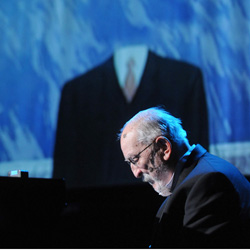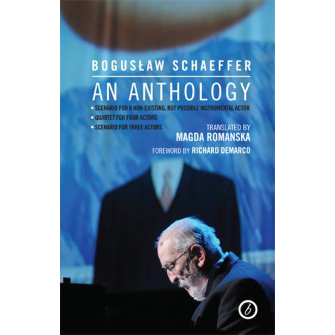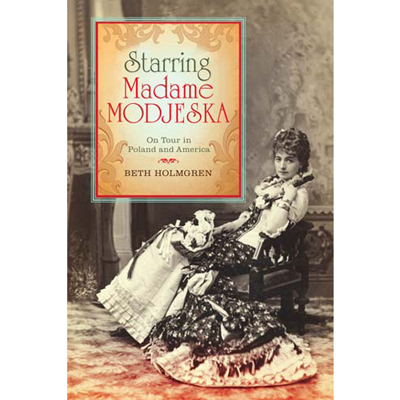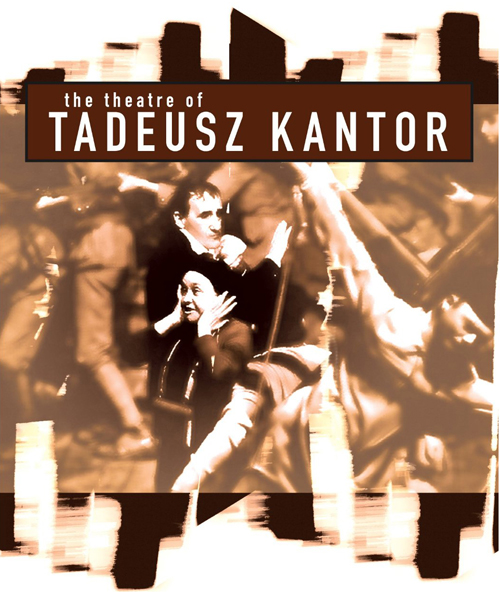
The following essay is the fifth in this six-part column for CR. Developed during Polish Movie Nite, a series of film screenings held at The Polish Club in San Francisco, these texts aim to introduce to an interested American audience a wide variety of subjects that might be classified “Polish.”
“The Theatre of Tadeusz Kantor” (1991) is a French documentary about the world-renowned theatrical artist named in the title. The film details Kantor’s life and work, and features illuminating interviews, sequences of the artist at work, and lengths of footage documenting the stage plays “The Dead Class” (1975) and “Wielopole, Wielopole” (1980). The following essay by artist Marcella Faustini speaks to her personal relationship with Kantor’s work, salvaging it from too-quick readings as sentimental, and closely considering the implications of his stage explorations. – JSz
Tonight I will be introducing The Theatre of Tadeusz Kantor, a documentary about painter, author, art theoretician, stage designer, theatre director, actor, and producer Tadeusz Kantor. Since the film contains a reasonable amount of biographical details, I will only briefly introduce his life. Kantor was born in 1915 in Wielopole, in the province of Tarnów. He was educated at the Academy of Fine Arts in Kraków and studied under Karol Frycz, an outstanding set designer of the inter-war period. Kantor taught as a professor at the Academy in the early ’40s while he worked as a director of experimental theatre. The later part of that decade saw him working extensively as a stage designer and spending time in Paris, which heavily influenced his practice. The ’50s saw him working on various painting exhibitions, taking part in the international documenta 2 exhibition in Kassel. Together with fellow Cracovian artists Maria Jarema and Kazimierz Mikulski, he started the Cricot 2 Theatre. Their first production was a play by Stanisław Ignacy Witkiewicz entitled The Cuttlefish. During the ’60s Kantor started staging his first happenings—these proved for him such a disappointment, that the experience led to his return to the theatre in the early ’70s. Starting in ’79, La Mama in New York staged The Dead Class, which won an Obie Award in 1980. They went on to stage various productions of Kantor’s plays in the U.S. and win him another Obie for Wielople, Wielopole in ’82. Throughout his career Kantor stayed heavily informed by Constructivism, Dada, Art Informel, and Surrealism. These influences were all visible in his various experiments with the Autonomous, Informel, Zero, Happening, and Impossible theatres of his creation. The last two decades of his life were the busiest in his theatrical career with his plays being staged all over the world. He died in 1990 in Kraków.
 My personal encounter with Kantor’s work happened while I was pursuing my undergraduate degree in Theatre. While directing a play about the making of Carl Dreyer’s The Passion of Joan of Arc, I came across the book A Journey Through Other Spaces: Essays and Manifestos, 1944–1990 (The University of California Press, 1993), a collection of Kantor’s writings compiled by theater scholar Michal Kobialka. As I became increasingly interested in the possibilities of theatre space and mise-en-scène, two figures loomed large within my thinking: Samuel Beckett and Kantor. As Beckett wrote in a production notebook, rejecting the new 20th century acting styles introduced by Constantin Stanislavski and Jerzy Grotowski, they were “not for me these Grotowskis and Methods” that were being paraded around by my professors. Both Beckett and Kantor seemed to be getting at something else using the theatrical frame: Beckett and his life-long pursuit of writing a play in which the text does away with the actor, and Kantor with a practical solution to this problem by way of a particular approach to stage objects and the physical space at hand. Furthermore, while both artists relied heavily on memory as subject, I came to find that theirs was also a theatre of forgetfulness—an aspect I could relate with immensely. Kantor was particularly successful with this thematic through his use of objects which became stand-ins, or more precisely annihilators, of any surrounding human presence. I became obsessed with constructing, as Kantor would say, “an autonomous field of action.” While I was getting increasingly annoyed with the implications of working with actors, the spatial possibilities of the stage became more and more of a focus in my work. As my work and the play developed, I created my own versions of stage props as machines, and incorporated objects in a way that scrambled their hierarchy within the action. Hierarchies were profoundly altered within Kantor’s plays: during his stagings he would be on the stage actively directing the actors; the audience sat on the same plane as the action; the actors were made to occupy the same space as the props. Furthermore, all of these elements could interchange functions: the actors became objects, the space turned into actors, and the objects became main players in continuous and hilarious permutations.
My personal encounter with Kantor’s work happened while I was pursuing my undergraduate degree in Theatre. While directing a play about the making of Carl Dreyer’s The Passion of Joan of Arc, I came across the book A Journey Through Other Spaces: Essays and Manifestos, 1944–1990 (The University of California Press, 1993), a collection of Kantor’s writings compiled by theater scholar Michal Kobialka. As I became increasingly interested in the possibilities of theatre space and mise-en-scène, two figures loomed large within my thinking: Samuel Beckett and Kantor. As Beckett wrote in a production notebook, rejecting the new 20th century acting styles introduced by Constantin Stanislavski and Jerzy Grotowski, they were “not for me these Grotowskis and Methods” that were being paraded around by my professors. Both Beckett and Kantor seemed to be getting at something else using the theatrical frame: Beckett and his life-long pursuit of writing a play in which the text does away with the actor, and Kantor with a practical solution to this problem by way of a particular approach to stage objects and the physical space at hand. Furthermore, while both artists relied heavily on memory as subject, I came to find that theirs was also a theatre of forgetfulness—an aspect I could relate with immensely. Kantor was particularly successful with this thematic through his use of objects which became stand-ins, or more precisely annihilators, of any surrounding human presence. I became obsessed with constructing, as Kantor would say, “an autonomous field of action.” While I was getting increasingly annoyed with the implications of working with actors, the spatial possibilities of the stage became more and more of a focus in my work. As my work and the play developed, I created my own versions of stage props as machines, and incorporated objects in a way that scrambled their hierarchy within the action. Hierarchies were profoundly altered within Kantor’s plays: during his stagings he would be on the stage actively directing the actors; the audience sat on the same plane as the action; the actors were made to occupy the same space as the props. Furthermore, all of these elements could interchange functions: the actors became objects, the space turned into actors, and the objects became main players in continuous and hilarious permutations.
In many ways, all of Kantor’s spatial explorations on stage pointed to a need to formally represent a threshold that lies between the perception, memory, and experience of inner space versus real space. Kobialka talks about Kantor collapsing four different types of spaces: “topos uchronia” (a place with no time), “heterotopias” (a counter-site to real space), “virtual space” (a place constituted by the overlapping of the real space and heterotopia), and “self-consistent space” (a space which does not have a counter-site, but exists for itself).
The other comforting factor in Kantor, for me, was the unapologetic point of reference of his work being completely locked within the experiential frame of the western world. As interested as I was in Noh, Butoh, and Bunraku, the comedy derived from Judeo-Christian historical absurdities and shortcomings had a lot more resonance for me. Kantor came of age in a time when, according to Adorno, the creation of autonomous works that are not governed by the external order of things but by their inherent structure created a way out of the post-Auschwitz impasse for speech and representation. In one of his essays on Kantor, Kobialka offers an example that illustrates this resolution. Kantor’s 1944 production of The Return of Odysseus took place in a bombed room instead of a theatre. It was not announced publicly since Polish cultural activities were expressly prohibited by the Nazis. Here the “real” object, namely the destroyed room, substitutes the “artistic” object, the theatre building. Being from a third world country, I can relate very closely to Kantor’s reasons for doing this. Unlike Duchamp’s ready-mades which were used as a way to challenge audiences’ perceptions about art, Kantor did so as a gesture of necessity. In his own words, “the objects manifested the anger of a human being being trapped by other human beasts. We only had the strength to grab the nearest thing. THE REAL OBJECT, and call IT the work of art.”
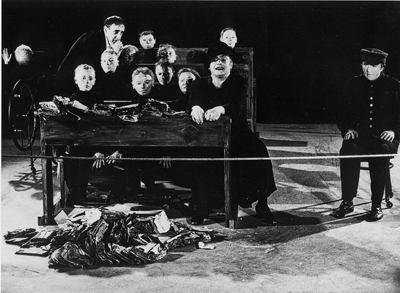 In terms of Kantor’s dramatic structuring, stock characters, sets, and props tend to appear and disappear not only during the play being staged, but they also make appearances in different ones in order to create an ongoing attempt towards the creation of a personal mythology. His use of chronology was closer to film than theatre. In his Theory of the Film Negatives, Kantor suggested that the events and characters on stage brought forth different memories, forever collapsing and folding into each other. And whereas film mimics the memory process, linearity was also ignored in his plays. Negatives are transparent, making it possible to see elements of frames seeping through each other. The idea of escaping the frame is also extrapolated in Kantor’s plays in a figurative way, with the characters and action gradually spewing out of it.
In terms of Kantor’s dramatic structuring, stock characters, sets, and props tend to appear and disappear not only during the play being staged, but they also make appearances in different ones in order to create an ongoing attempt towards the creation of a personal mythology. His use of chronology was closer to film than theatre. In his Theory of the Film Negatives, Kantor suggested that the events and characters on stage brought forth different memories, forever collapsing and folding into each other. And whereas film mimics the memory process, linearity was also ignored in his plays. Negatives are transparent, making it possible to see elements of frames seeping through each other. The idea of escaping the frame is also extrapolated in Kantor’s plays in a figurative way, with the characters and action gradually spewing out of it.
It could be relatively easy to read his work as sentimental; if, at first glance, to our over-exposed sensibilities the work seems to be fraught with sentimentalism, I suggest a double take. What you are seeing is the stacking of dadaist formal strategies on top of self-referential cultural tropes which, in some cases, provokes an intense emotional response. Here too hierarchy is done away with: laughter and crying are of the same difference. This hierarchical interchangeability is, to me, the actual crux of interest in Kantor’s work. His interest in bringing to the forefront the in-betweens of life—the weathered, the lowly, the places where logic unravels—and to catapult them towards a transformation into the main point of interest remains a great strategy in art-making. A short note about his staging of The Return of Odysseus further elaborates his embrace of life and its reality of the lowest rank:
Warning: Let us beware and not place easily our trust in individuals who, misusing those metaphysical reasons, offer us gloomy and blunt pathos or the pretentious and empty gestures of shamans. A feeling of a tightrope dance, irony, sarcasm , and a sense of humour are a human aspect of metaphysics. this is a positive part of our inheritance from the age of REASON. One more thing that is seldom taken into consideration: all forms (in art), whose highest goal is to affirm life in the world known as “the other side are OPPOSED to life as well as to the status and code of life. They are ANTITHETICAL to life, and that is why they are scandalous and shocking when defined in terms of its categories. This is why my Zero Theatre (1963) was a theatre of phenomena states that exist “below zero” and was directed towards emptiness, indistinctness, and “low” values. This was why I proclaimed the realness of lowest MATERIALISTIC regions and (horrors!) of moral ones. This was why in theatre I substituted the archaic, pathetic, and “divine” concept of reincarnation for the human act of imposture, which admitted to the stage swindlers and crooks; for sneaking in, which reflected the obscure methods of “impure forces; for transformation, which connoted a psychological process that was coloured by mysticism. But I always felt this mysterious tremor and awe-inspiring sensation of “the other world” in all those real processes of the lower rank. . . . I felt this tremor while waiting at the station for Odysseus’ return from Troy.”
– Marcella Faustini
Marcella Faustini is an artist and curator. She is the Artistic Director at Noma Gallery, San Francisco. She earned her MFA at the California College of the Arts in San Francisco. Originally from Brazil, she is now neither from here nor from there.
More information about PMN is available at http://polishmovienite.blogspot.com
